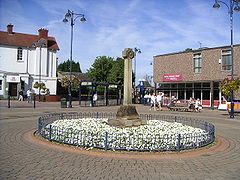Wath upon Dearne
| Wath-upon-Dearne | |
|---|---|
 The Market Cross, Montgomery Square, Wath-upon-Dearne |
|
| Wath-upon-Dearne shown within South Yorkshire | |
| Population | 8,604 (2011 census) |
| OS grid reference | SE438008 |
| Metropolitan borough | |
| Metropolitan county | |
| Region | |
| Country | England |
| Sovereign state | United Kingdom |
| Post town | ROTHERHAM |
| Postcode district | S63 |
| Dialling code | 01709 |
| Police | South Yorkshire |
| Fire | South Yorkshire |
| Ambulance | Yorkshire |
| EU Parliament | Yorkshire and the Humber |
| UK Parliament | |
Wath-upon-Dearne (also known as Wath-on-Dearne or simply Wath) is a small town on the south side of the Dearne Valley in the historic county of the West Riding of Yorkshire and the Metropolitan Borough of Rotherham, South Yorkshire, England, lying 5 miles (8 km) north of Rotherham, almost midway between Barnsley and Doncaster. It has a population of 16,787. It is twinned with Saint-Jean-de-Bournay, in France.
Wath can trace its existence back to Norman times, having an entry in the Domesday Book as Wad. For hundreds of years it remained a quiet rural settlement astride the junction of the old Doncaster-Barnsley and Rotherham-Pontefract roads, the latter a branch of Ryknield Street. North of the town was the ford of the River Dearne by this road that gave the town its name: the origin of its name has been linked to the Latin vadum and the Old Norse vath (ford or wading place). The town received its Royal Charter in 1312 – 13 entitling it to hold a weekly Tuesday market and an annual two-day fair, but these were soon discontinued. The market was revived in 1814.
Until the mid-19th century the town was home to a racecourse of regional importance, linked to the estate at nearby Wentworth; the racecourse later fell into disuse although traces of the original track can easily be found between Wath and Swinton and its memory is left in local street names. There also was a pottery at Newhill, close to deposits of clay, although this always lived under the shadow of the nearby Rockingham Pottery in Swinton. Around the turn of the 19th century the poet and newspaper editor James Montgomery, resident in Wath at that time, described it as "the Queen of villages". This rural character was to change rapidly in the 19th and 20th century with the development of the deep mining industry.
...
Wikipedia

